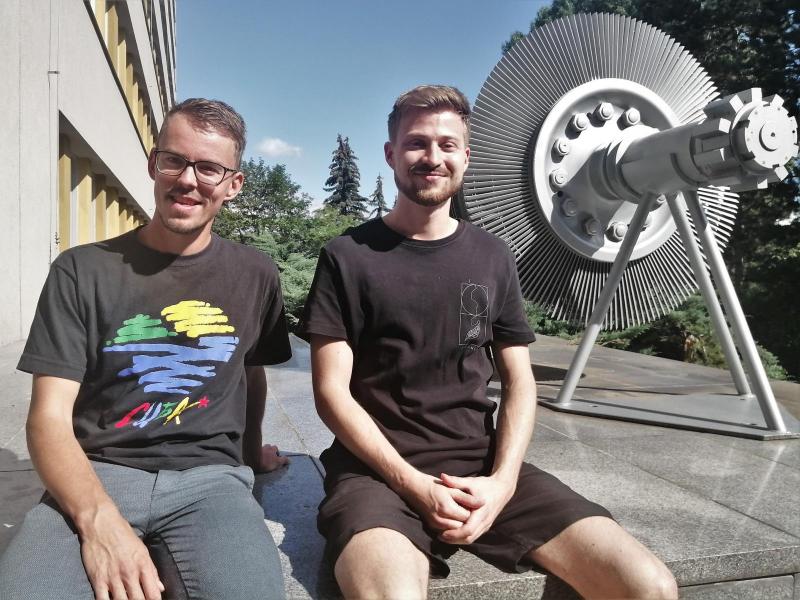Topic
Doctoral students in engineering study the behaviour of the circulatory system. Neural networks also help them

When different technical disciplines are combined, students of BUT (Brno University of Technology) can “dabble” in medicine. Four doctoral students are focusing on researching the circulatory system by controlling a peristaltic pump that replaces the human heart in the laboratory. They want to better grasp the influence of pathologies on the behaviour of the cardiovascular system, which may help with early diagnosis and also reduce blood cell damage in patients connected to a pulmonary bypass or ECMO machine.
“In the future, we would like to come up with a methodology for evaluating the severity of stenosis, i.e. the narrowing or restriction of blood vessel patency. Nowadays, doctors recommend surgery to patients based on what percentage of the blood vessel is impassable. Sometimes, however, even a patient with a large narrowing can live on without major surgery, while other times a stroke can occur even if the narrowing is not so large. That is why the effort to develop a more sophisticated criterion is based on non-invasive examinations, for example CT and ultrasound,” explains Jiří Jagoš, a doctoral student from the Faculty of Mechanical Engineering, who studies at the Institute of Body Mechanics, Mechatronics and Biomechanics.
In order to better understand how pathology affects a patient's circulatory system, the experimental circuit in the laboratory that students built this year is intended to serve as a tool. The silicone tubes in it represent blood vessels that branch from the large arteries to small hair cells in the periphery. The heart is represented by a peristaltic pump, which is also commonly used in medicine, for example during heart surgery or in ECMO machine.

The shape of the wave is influenced not only by heart disease, such as arrhythmias, valve defects or coronary artery disease, but also by various changes in the vascular system itself. For example, high blood pressure can be a symptom of natural ageing and hardening of the arteries, or more often of an unhealthy lifestyle in younger patients. “It is not for nothing they say that one is as old as ones arteries. In the future, we also want to install so-called phantoms, i.e. realistic models of large arteries, such as the aorta, where we can create various pathologies,” adds Jagoš.
Blood cells in danger
For the young researchers, the key to understanding the circulatory system is the pressure wave forms that the heartbeats in human arteries, now simulated in the laboratory, create. Blood is not a simple liquid in terms of mechanics and the whole plot is rather non-intuitive. That's why neural networks are taking over one of the tasks for humans, which the doctoral students are teaching to recognise the dependence between the rotation speed of the pump rotor and the pressure wave in the “cardiovascular” system. “We need a sophisticated algorithm that can predict this dependency. Already from the first dataset of five hundred measurements, the neural networks learned to predict with a 97 percent success rate, which pleasantly surprised us,” says Kohút.
The human body is an amazing machine that you just have to discover and be inspired by.
Since they use a common peristaltic pump in medical practice, they decided to tackle one more problem: haemolysis. This is the term doctors use to describe the deterioration and breakdown of red blood cells. It can occur just when using a pump to pump blood. The high pressure in one part of the tube and the vacuum in the other part of the tube, when released, results in a violent oscillation that is not good for the blood cells and may even destroy them. “In medicine today, constant speed pumps are used. We want to use a mathematical model to calculate whether modifying the speed in one of the rotation phases would help to reduce this oscillation, thereby preventing haemolysis to some extent,” Kohút believes.
This one can do this and that one can do that.

As the students point out, such complex research would not be possible without the collaboration of people from different disciplines. In addition to the fact that each of the four is an expert in a different field, they also work with experienced colleagues or directly with doctors.
You can see how fascinated they are by the connection between technical knowledge and the human body. For example, when Jiří Jagoš describes how the pressure wave from the heart is gradually mushed in the cardiovascular system. “The blood flows into the target organ with a subdued pulse so that the strong pulses do not injure the organ; it is an almost continuous flow. The body evenly supplies the organ with blood, like when you water the garden perfectly. The human body is an amazing machine that you just have to discover and be inspired by,” concludes Jagoš.
(ivu)
ARGO underwater: Prototype of student submarine on display at IDET Fair
Martin Cígler: The biggest obstacle to faster a development of it is the lack of people
Women from BUT who move the world of science and technology
Young scientists want to use Cubesat to photograph the solar eclipse from the space
Auxetic material behaves differently than you would expect, says student Tomáš Vítek